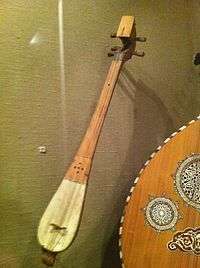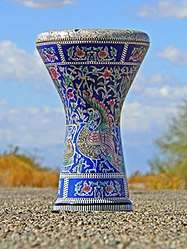Qanbūs
A qanbūs or gambus (Arabic: قنبوس) is a short-necked lute that originated in Yemen and spread throughout the Arabian peninsula. Sachs considered that it derived its name from the Turkic komuz, but it is more comparable to the oud.[1] The instrument was related to or a descendant of the barbat.[2] It has twelve nylon strings that are plucked with a plastic plectrum to generate sound, much like a guitar. However, unlike a guitar, the gambus has no frets. Its popularity declined during the early 20th century reign of Imam Yahya; by the beginning of the 21st century, the oud had replaced the qanbūs as the instrument of choice for Middle-Eastern lutenists.
Yemen migration saw the instrument spread to different parts of the Indian Ocean. In Muslim Southeast Asia (especially Indonesia, Malaysia and Brunei), called the gambus, it sparked a whole musical genre of its own. Today it is played in Johor, South Malaysia, in the traditional dance Zapin and other genres, such as the Malay ghazal and an ensemble known as kumpulan gambus ("gambus group"). Kumpulan gambus can also be found active in Sabah, especially in the Bongawan district of East Malaysian Borneo. In the Comoros it is known as gabusi,[3] and in Zanzibar as gabbus.
Sources
- ↑ The gambus (lutes) of the Malay world: its origins and significance in zapin Music, Larry Hilarian, Nanyang Technological University, Singapore, 06 Jul 2004
- ↑ Hiliarian, Larry Francis. "Documentación y rastreo histórico del laúd malayo (gambus) [translation: Documentation and historical tracking of the Malayan lute (gambus)]". scielo.org. Retrieved 13 August 2018.
El gambus melayu que ahí llegó podría ser, o bien un descendiente directo del barbat persa, o del qanbus yemenita, que a su vez evolucionó del barbat.[translation: The melayu gambus that arrived there could be either a direct descendant of the Persian barbat, or the Yemenite qanbus, which in turn evolved from the barbat.]
- ↑ Simon Broughton; Mark Ellingham; Richard Trillo (1999). World Music: Africa, Europe and the Middle East. Rough Guides. pp. 505–. ISBN 978-1-85828-635-8. Retrieved 18 September 2012.
References

- Poche, Christian. "Qanbūs". Grove Music Online (subscription required). ed. L. Macy. Retrieved on August 15, 2007.
- Gambus - Musical instruments of Malaysia
- Charles Capwell, Contemporary Manifestations of Yemeni-Derived Song and Dance in Indonesia, Yearbook for Traditional Music, Vol. 27, (1995), pp. 76–89 reg
Kinzer, Joe. "The Agency of a Lute: Post-Field Reflections on the Materials of Music." Blog post. Ethnomusicology Review: Notes from the Field. UCLA,2016.
See also
Further reading
- Qanbus, Kigangala, & Gabusi: A Portfolio. Monoxyle Lutes/Index v.21 March 2016
